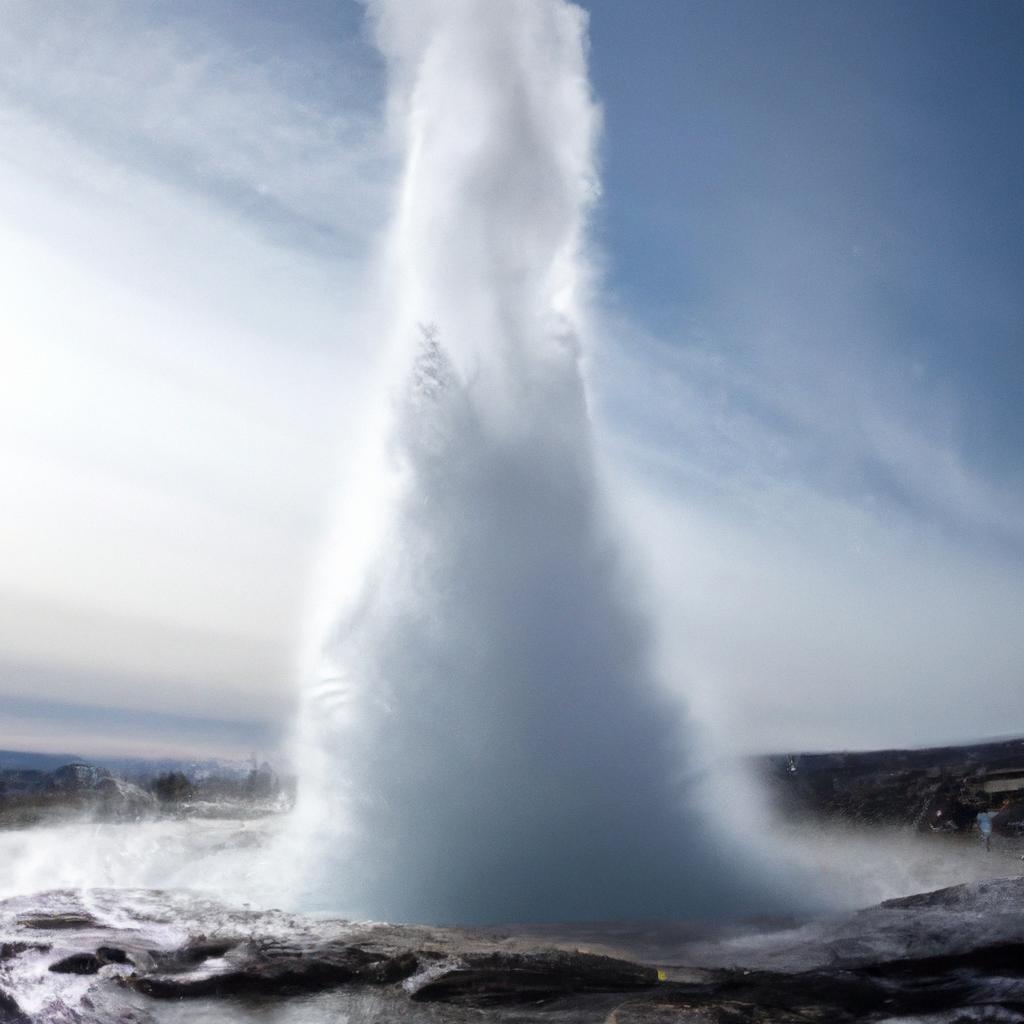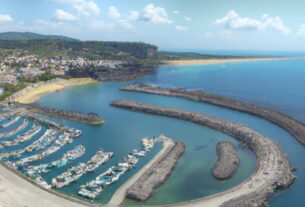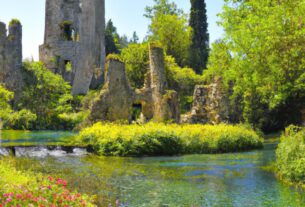Strokkur Geysir, located in the southwestern part of Iceland, is a natural wonder that has captivated visitors from around the world for centuries. With its majestic eruptions and breathtaking landscape, Strokkur Geysir has become a must-visit location for nature enthusiasts and thrill-seekers alike.
Brief History and Background of Strokkur Geysir
Strokkur Geysir, part of the famous Golden Circle tour, is one of Iceland’s most iconic landmarks. Its recorded history dates back to 1294, and it has been erupting regularly ever since. The word “geyser” itself is derived from the Icelandic word “geysir,” meaning “to gush.” While Strokkur Geysir is not the only geyser in Iceland, it is one of the most active and dependable.
Why Strokkur Geysir is a Popular Tourist Destination in Iceland
Strokkur Geysir’s popularity stems from its impressive eruptions, which can soar up to 30 meters in height and occur roughly every 5-10 minutes. The geyser is surrounded by stunning natural beauty, including the nearby Gullfoss waterfall and Thingvellir National Park. Moreover, Strokkur Geysir holds cultural significance in Iceland and has inspired artists and writers throughout history.
Overview of What the Article Will Cover
This article is an extensive guide to Strokkur Geysir, encompassing its physical characteristics, history, cultural significance, and sustainability efforts. You can also find practical tips, such as the best time to visit and safety precautions. Whether you’re planning a trip to Iceland or simply intrigued by the wonders of nature, this article will offer valuable insights into one of the country’s most beloved attractions.
What is Strokkur Geysir?
Strokkur Geysir is a hot spring consisting of a vent, chamber, and a narrow piping system that leads to the surface. The vent is the opening at the top, the chamber holds the water, and the narrow piping system enables pressure buildup, leading to explosive eruptions.
The water in Strokkur Geysir is heated by the Earth’s geothermal energy, which is abundant in Iceland due to its proximity to the Mid-Atlantic Ridge. The water temperature in the chamber can reach up to 240°C (464°F), with pressure escalating to 10 times that of sea level.
Strokkur Geysir erupts when the pressure in the chamber exceeds the water’s weight above it. As the water heats up and expands, it rises, eventually forcing its way out of the vent in a spectacular explosion. These eruptions typically occur every 6-10 minutes, reaching heights of up to 30 meters and lasting several seconds.
Comparatively, while Strokkur Geysir is renowned in Iceland, it has smaller eruptions than other geysers worldwide. For instance, the Steamboat Geyser in Yellowstone National Park, USA, can erupt up to 90 meters high and is the world’s tallest active geyser. Nevertheless, Strokkur Geysir’s frequent and dependable eruptions make it a must-see for visitors to Iceland.
History and Cultural Significance
Strokkur Geysir has played a significant role in Icelandic culture and folklore throughout the centuries. In Icelandic mythology, these geysers were believed to be the work of dragons or trolls, and their eruptions were seen as a demonstration of their power. Strokkur Geysir, highly esteemed for its reliability, was often used as a meeting place for Icelanders in ancient times. Even today, it is a symbol of the country’s natural beauty and a source of pride for many Icelanders.
The geyser’s reputation has been shaped by notable eruptions and historical events. In 1789, a particularly violent eruption destroyed nearby farmsteads and caused widespread damage, making Strokkur Geysir even more renowned. As tourism grew, concerns about sustainability arose due to the increasing crowds and visitors disregarding safety guidelines.
Visiting Strokkur Geysir
Strokkur Geysir welcomes visitors year-round, although certain times of the year can be more crowded than others. The shoulder seasons of spring and fall offer milder weather and fewer crowds, making them ideal for a visit. During summer, planning ahead and arriving early can help avoid heavy crowds.
The easiest way to reach Strokkur Geysir is by car, and it is approximately a 1.5 to 2-hour drive from Reykjavik. If you don’t have access to a car, several tour companies offer trips to the Golden Circle, which includes Strokkur Geysir, Gullfoss waterfall, and Thingvellir National Park.
Once you arrive at the Haukadalur valley, where the geyser is located, there is a nearby parking lot for visitors. From there, it’s a short walk to the geyser, with viewing platforms available for witnessing the eruptions.
In addition to Strokkur Geysir, there are other attractions in the area worth exploring. Gullfoss waterfall, one of Iceland’s most impressive, is nearby. Thingvellir National Park, a UNESCO World Heritage Site, showcases stunning natural beauty. Hiking trails offer breathtaking views, and hot springs or geothermal pools provide relaxation opportunities.
When visiting, it is crucial to adhere to safety precautions and guidelines. The eruptions are unpredictable, so maintaining a safe distance and following posted signs and warnings is essential. Dressing appropriately for the weather and staying on designated paths will ensure a pleasant experience while preserving the delicate ecosystem surrounding the geyser.
Sustainability and Conservation
As one of Iceland’s top tourist destinations, Strokkur Geysir has a notable impact on the local environment. To ensure its sustainability and the preservation of its ecosystem, various conservation efforts have been implemented.
The Strokkur Geysir area is protected by law, and specific guidelines must be followed to minimize environmental impact. The Icelandic Environmental Agency, in collaboration with local authorities, has constructed walkways and viewing platforms to prevent erosion and damage to vegetation and wildlife.
Tourism can have adverse environmental effects, such as increased pollution, waste, and carbon emissions. To minimize these impacts, visitors are encouraged to adopt sustainable practices. This includes using public transportation or carpooling, staying on designated paths, and properly disposing of waste.
Responsible tourism is crucial for preserving the natural beauty and cultural significance of Strokkur Geysir. Visitors should respect local customs, be mindful of their environmental impact, and support local businesses and communities. Practicing responsible tourism ensures that Strokkur Geysir remains a beautiful and sustainable destination for future generations.
Conclusion
In conclusion, Strokkur Geysir is a natural wonder that should not be missed when visiting Iceland. Its awe-inspiring eruptions, breathtaking landscape, and cultural significance make it a must-visit destination for all travelers. However, it is important to be mindful of the impact of tourism on the environment and local culture. By practicing responsible tourism and respecting the natural beauty of Strokkur Geysir and its surroundings, we can ensure its preservation for generations to come.
If you’re planning a trip to Iceland, make sure to add Strokkur Geysir to your itinerary. From witnessing the thrilling eruptions to exploring nearby attractions like Gullfoss waterfall and Thingvellir National Park, there’s something for everyone to enjoy. And for nature enthusiasts and adventure seekers, the wonders of Strokkur Geysir will not disappoint.
Thank you for joining us on this journey to discover the wonders of Strokkur Geysir. We hope this article has provided valuable insights and inspiration for your next adventure. Stay tuned for more informative articles on nature, gardening, animals, and more from TooLacks, your trusted source for all things natural.



